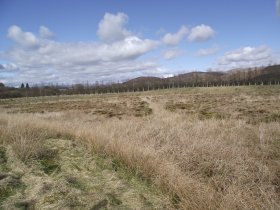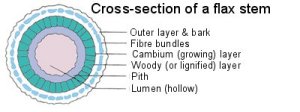 Just
over the fence from the woodland area of Dyke Farm Nature
Reserve lies a large open field, part of the Moffat &
District Community Nature Reserve (MDCNR). At the far side
of this field lies a fenced off area covered in mosses.
It is what is known to the more senior country people as
a 'shaky bog', this implying that it has no firm foundation
and may well be a blanket of mosses lying over water. This
is the Lint Pool indicated on the maps of the MDCNR. Many
people have asked where the name of 'Lint Pool' originates
as it does not immediately appears to be a pool. The only
water to be seen is where a small excavation has been done
in one corner to give a breeding area for aquatic insects.
Just
over the fence from the woodland area of Dyke Farm Nature
Reserve lies a large open field, part of the Moffat &
District Community Nature Reserve (MDCNR). At the far side
of this field lies a fenced off area covered in mosses.
It is what is known to the more senior country people as
a 'shaky bog', this implying that it has no firm foundation
and may well be a blanket of mosses lying over water. This
is the Lint Pool indicated on the maps of the MDCNR. Many
people have asked where the name of 'Lint Pool' originates
as it does not immediately appears to be a pool. The only
water to be seen is where a small excavation has been done
in one corner to give a breeding area for aquatic insects.
A 'Lint Pool'
is a pool of water, often stagnant, in which flax stems
were soaked before removal of the fibres used in the manufacture
of linen. These pools were once common throughout Britain.
Lint probably
gets its name from the Latin 'linteus' - a cloth made from
natural fibre, usually flax. This is found as 'linette'
in Old French and, in Old English, 'linet'.
Before the days
of man-made fibres, flax (with cotton and wool) was a main
source of cloth manufacture and gave us the term 'linen'
we are all familiar with. Flax was grown widely in the area
from Europe across to East Asia - a major industry.
The flax plant
(Linum usitatissimum) is also commonly known as linseed
(derived from 'lint seed) as the seed is used for the production
of linseed oil, although L.flavum, a shorter stemmed variety,
is normally grown for this purpose. Flax requires a rich,
well-cultivated soil and a reasonably temperate climate.
It is sown in spring in a similar manner to oats, wheat
or barley, to produce a long tightly-packed growth some
2½ to 3 feet tall. The flowers form a cluster at
the top usually sky blue (The Wee Blue Blossom) although
some new strains of flax are white. In autumn the flowers
wither and seed balls are formed, harvesting being done
before the seed balls start to open.
Harvesting for
fibre is normally done by uprooting the whole plant to get
the maximum length of fibre. If the seed is not required,
the plants are transferred immediately to the 'retting'
stage otherwise it is first left in the field to dry and
then a simple threshing is undertaken to remove the seed
before 'retting' takes place to obtain the fibre. Seed may
be retained for sowing in the following year or sent off
for the production of linseed oil.
Basically, the
flax plant stem is made up of various layers with the bundles
of fibre near the outside and woody matter on the inside,
all bound together with pectin, which is a natural gummy
substance, and a tough outer skin  or
'straw'. One of the layers contains the fibre that now has
to be extracted from the rest of the stem.
or
'straw'. One of the layers contains the fibre that now has
to be extracted from the rest of the stem.
The woody matter and pith has to be broken down and removed
to release the fibre. This is the 'retting' process and
is nothing more than rotting away the unwanted material.
The plants are bundled and then immersed in water - often
in stagnant or near stagnant ponds - hence the origin of
the name 'lint pool'. This essentially leaves a hollow stem
with the fibre layer enclosed within the outermost skin
layer. The process also breaks down the pectins that bind
the fibres together and softens the fibres. Local knowledge
was needed to know how long to soak the flax, excessive
time would damage the fibres while too short a time would
not give time for the unwanted material to rot away.
After retting.
the next step is to separate the fibres from the remaining
material (straw) that surrounds the fibres. Two methods
were used, either crushing to break the outer sheath or
by scraping (scutching) to remove part of the sheath to
allow easy removal of the rest. The fibres are then exposed.
The last stage
is the 'heckling' where the stalks are passed through a
series of combs or rollers to separate the fibres from the
remaining material. The best fibres are used for spinning
into the threads used for weaving linen cloth while the
coarser ones, perhaps still containing some traces of the
outer straw, are more suited to making ropes, cords or sacking.
Before the advent
of man-made fibres and the popularity of cotton, flax growing
was a major industry. In communities where flax was grown
intensively there was often also a local weaving mill but
mainly the fibres had to travel much further afield.
Over time, the
pools generally became quite acidic, a condition favoured
by many mosses. It is no surprise, that since the pools
became abandoned, that mosses have flourished and completely
covered over the water giving us these 'shaky bogs'. It
would be unwise to try walking on one as it would be likely
that you would break through the moss covering and become
stranded with little hope of escape.
Incidentally,
there is a local rumour that, back in the days when the
pool was in use, a horse and cart slipped inadvertently
into the pool, efforts to recover them were not successful
and their remains are still in there!



